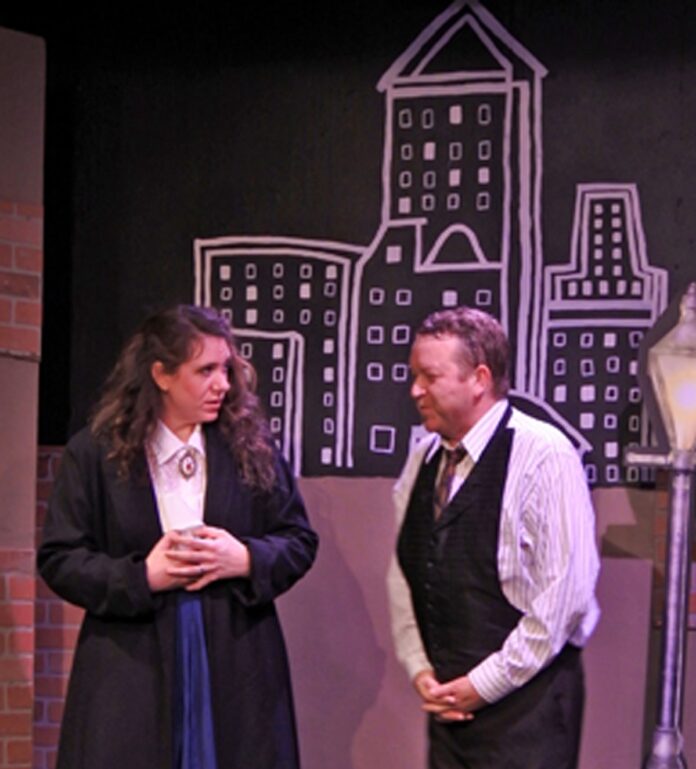Eighteen months ago, Moxie Theatre modified their productions for Zoom viewers to attend live performances from the confines of home while Lamplighters Community Theatre temporarily dropped their curtain until opening their 83rd season to masked and vaccinated patrons in September 2021.
Moxie Executive Director Jennifer Eve Thorn said the past two years leveled the field to a certain extent, as companies throughout the theatre community were all handling the same challenges.
“It’s rare that Moxie is struggling with the same issue that, say, the La Jolla Playhouse is facing and we developed a sense of responsibility for each other and the wellness of our organizations. Suddenly, there were personal emails from people checking in on others,” Thorn said.
Although the public couldn’t see that development, she said the connection was vital.
“What also helped us survive was building closer relationships with our audiences. At the beginning, we took the time to call our entire subscriber base to check on them and ask if they wanted to see us do anything. It took mountains of time but that project really built our connection with them, it helped us to survive and it developed into our 12-week Zoomfest,” Thorn said.
Meanwhile, the omnipresent question of physical health segued into a conversation on mental health in the workplace, specifically the hours involved with mounting a live show.
“You’re starting to see organizations shift the way they work and plan around mental health. We used to take pride in our willingness to work longer hours than anyone outside of the medical industry. Most theatre people have their story of a vomit bucket between scenes and we’re used to ‘Hell Week’ or rehearsing for a ‘10 out of 12’ hour workday. We did that as a way of convincing ourselves that what we were doing was okay and special, unlike any other job,” Thorn said.
Those rigorous practices are rapidly shifting, she said, with “theatres at every level banning ‘10 out of 12s and leaders saying ‘don’t come to work if you’re sick’, which would not have happened prior to the pandemic.
Their biggest challenge now is not health but funding, Thorn said.
“It’s easy to think ‘we’ve come through the hard times’ but our relief funding is gone and our audiences are still at 50%. People are tired of hearing how we need support but we won’t make a full recovery for years. The cost of producing has gone up and we are only halfway up the hill,” Thorn said.
Lamplighters Community Theatre Board of Directors President Paul Ericson echoed Thorn: they too are struggling to fill the house, and have noticed some regular audience members have not returned.
“We’ve noticed some audience members have not come back. Nights that we used to run at about three-quarters full are now at half,” Ericson said, prompting the community theatre group to “try a few nibbles into paid online advertising, which we’ve never done before” in a bid to attract a younger audience.
Lamplighters Community Theatre Producer Pamela Stompoly, who also serves as Chair of their play selection committee said she is challenged by an extended production timeline that has become necessary, in part because so many theatres are auditioning and in part because actors are trying to make up for lost time.
“The San Diego talent pool isn’t big enough to give each theater who and what they would love to cast. For example, we’re auditioning for ‘One Flew Over the Cuckoo’s Nest’ right now and I want to be picky but three other theaters are also holding auditions. Then, an actor will be cast in a show but they’re performing or rehearsing for a different show to try and earn a stipend. It’s very frustrating,” Stompoly said.
To meet the challenge, they have begun to audition for shows months in advance so they can hold rehearsals with different combinations of actors based on similar schedules.
Directors have also begun to talk with actors during auditions about doing different shows, pushing the envelope and addressing topics with challenging shows that likely would not have been part of their season before the social unrest of 2020.
“We’re trying to do different shows with different viewpoints but we also don’t want to drive away our audience base, the people who have kept us alive forever and ever and ever, or alienate them by going so far out there that they don’t enjoy going to the show. We’ve had people dislike some of our choices so much they don’t renew their season subscription,” Stompoly said.
The small theatre company has landed on a “happy medium” of plays everyone knows, some that nobody seems to have heard of and a few that have some recognition.
Still, Stompoly said, although they are dedicated to mounting newer, challenging shows, it was notable that over 70 people showed up to audition for ‘Cuckoo,’ scripted in 1975, where they used to get fewer than 20 people auditioning for any one part.
Production costs are higher than ever, Stompoly said, forcing the small company to get creative with their designs. Rather than building traditional sets, they’ve begun utilizing the relatively small Lamplighters’ space differently, blowing out into the sides of the proscenium and playing around with staging to produce unique shows without increasing their design budget.
“We’re also being strategic with our timing, like we’re getting more into musicals but we’re not going to try and compete with something like the Coronado playhouse where 75% of what they do is a musical on a huge stage. Rather, we’re trying to work with other Association of Community Theatres. If someone is doing a drama, then we’ll do a comedy or we’ll do a musical while nobody else is doing one so we’re not going to be competing with each other,” Stompoly said, let alone attempting to compete with big-budget traveling Broadway shows which pass through San Diego.
Regardless of challenges that have emerged in the wake of the pandemic, Lamplighters Stompoly and Ericson, and Moxie’s Thorn all said live theatre is irreplaceable.
“Unlike social media, seeing live theatre is something you do with other people. People think they like seeing the performers live but the other half is witnessing together as a community. You hear other people laughing near you; people come from different homes and socioeconomic backgrounds to sit in the same space and the people who love theatre do it for that. We speak to each other and treat each other in a completely different way when we’re face to face and it makes us better humans to share space together,” Thorn said.
There will always be a group of people who love to sit in a theater together in a first-hand experience, Stompoly said, and “that’s a good thing” as it provides a medium that cannot be replicated online.
“Everyone’s working together to figure this situation out.”














